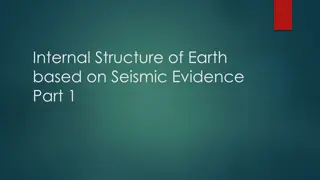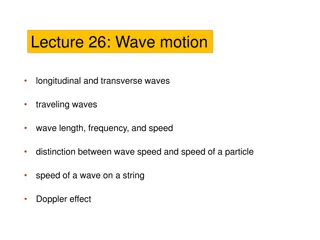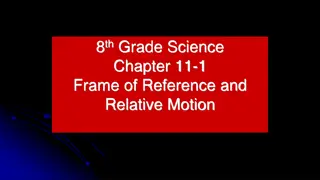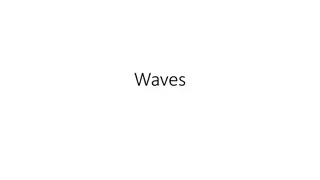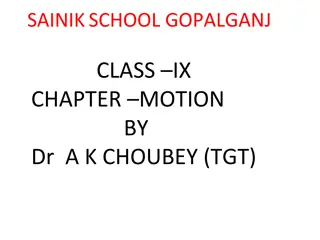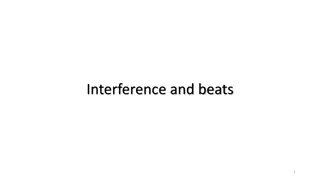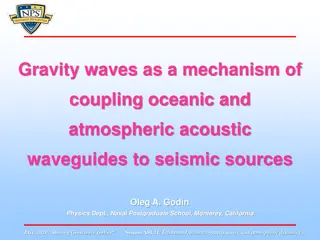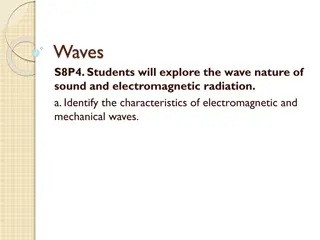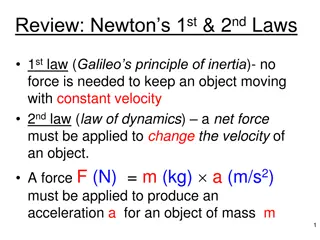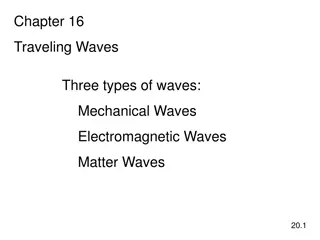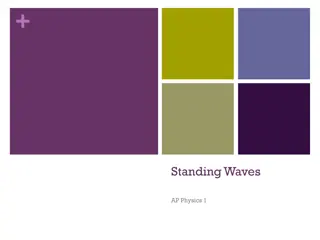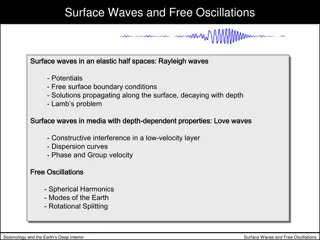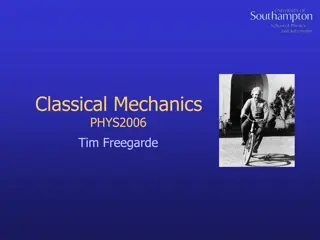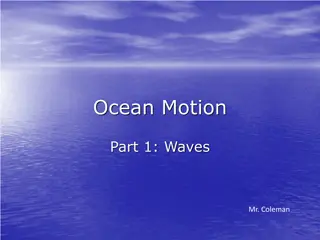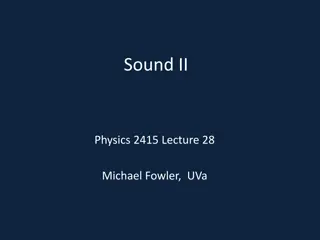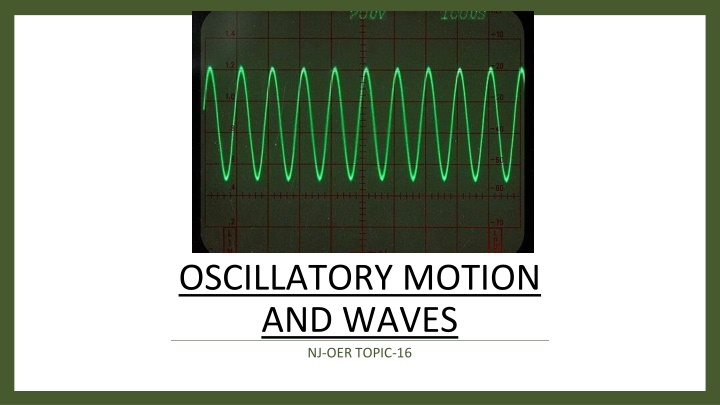
Understanding Oscillatory Motion and Waves in Physics
This educational resource delves into the concepts of oscillatory motion and waves in physics, covering topics such as period, frequency, angular frequency, simple harmonic oscillators, wave characteristics, interference, and more. It also explains the relationships between motion parameters and dynamic properties, providing detailed information on calculations, equations, and learning outcomes. The material is licensed under Creative Commons and is part of the Open Textbook Collaborative project, aimed at creating open educational resources for STEM courses.
Download Presentation

Please find below an Image/Link to download the presentation.
The content on the website is provided AS IS for your information and personal use only. It may not be sold, licensed, or shared on other websites without obtaining consent from the author. If you encounter any issues during the download, it is possible that the publisher has removed the file from their server.
You are allowed to download the files provided on this website for personal or commercial use, subject to the condition that they are used lawfully. All files are the property of their respective owners.
The content on the website is provided AS IS for your information and personal use only. It may not be sold, licensed, or shared on other websites without obtaining consent from the author.
E N D
Presentation Transcript
OSCILLATORY MOTION AND WAVES NJ-OER TOPIC-16
Original Publication Year 2022 General Physics I by Moe Tabanli is licensed under aCreative Commons Attribution-NonCommercial-ShareAlike 4.0 International License, except where otherwise noted. To learn more about the Open Textbook Collaborative, visit https://middlesexcc.libguides.com/OTCProject Under this license, any user of this textbook or the textbook contents herein must provide proper attribution as follows: If you redistribute this textbook in a digital or print format (including but not limited to PDF and HTML), then you must retain this attribution statement on your licensing page. If you redistribute part of this textbook, then you must include citation information including the link to the original document and original license on your licensing page. If you use this textbook as a bibliographic reference, please include the link to this work https://opennj.net//physics- tabanli in your citation. For questions regarding this licensing, please contact library@middlesexcc.edu Funding Statement This material was funded by the Fund for the Improvement of Postsecondary Education (FIPSE) of the U.S. Department of Education for the Open Textbooks Pilot grant awarded to Middlesex College (Edison, NJ) for the Open Textbook Collaborative. Open Textbook Collaborative The Open Textbook Collaborative. (OTC) project is a statewide project managed by Middlesex College along with assistance from Brookdale Community College, Ocean County College , Passaic County Community College, and Rowan University . The project engages a consortium of New Jersey community colleges and Rowan University to develop open educational resources (OER) in career and technical education STEM courses. The coursesalign tocareer pathways in New Jersey s growth industries including health services, technology, energy, and global manufacturing and supply chain management as identified by the New Jersey Council of Community Colleges.
Relate period, frequency and angular frequency for an oscillatory motion Distinguish between the motion parameters A,f,T,w and the dynamic properties such as mass, moment of inertia, spring coefficient, gravity etc. Calculate motion parameters from the dynamic properties Describe a simple harmonic oscillator equation Write the equation of motion using the motion parameters From a given equation of motion, estimate motion parameters and dynamic variables Explain the link between simple harmonic motion and waves. State characteristics of waves and standing waves Understand the role of wavelength in destructive and constructive interferences Learning Outcomes
F= force k= spring constant x= displacement from equilibrium position f = frequency T= period = angular frequency A = Amplitude of displacement = angular displacement max= Amplitude of a pendulum = phase constant m = mass Vmax= maximum velocity amax= maximum acceleration = wavelength Concepts
SI UNITS Force is in Newtons Frequency is in Hz angular frequency is in rad/sec Period is in seconds (s) angular displacement is in radians phase constant is in radians Mass is in Kg wavelength is in meters (m) Amplitude is in meters (m) Velocity is in m/s Acceleration is in m/s2 Units
f = 1/T f = 1/T = 2 f 2 f Springs F= -k(x-xo) E= k A2 E= m vmax2 x= A cos ( t) x-oscillation starting at A x= A cos ( t+ ) 2= k/m Pendulum = max cos ( t+ ) 2=g/L Simple Pendulum 2= mgR/I Physical Pendulum Waves v = f = /T Formulas and Constants
KEY STRATEGIES f, T and are related, knowing one means knowing all f = 1/T = 2 f Above equations applies to all Simple Harmonic Motion (SHM) The equation that connects dynamic variables to kinematics are different for each system 2= k/m for spring 2= k/m2= g/L for the simple pendulum If the equation of motion is given, A, , can be found by matching the variables. Other unknowns can be calculated x = 3.2 cos (5 t + 0.2) x= A cos ( t + ) If A, , are given or can be calculated, equation of motion can be found by substituting = 0 If the motion starts from xmax=A
CLASSWORK FOR SHM OF A SPRING Mass "m" is oscillating on a spring with spring coefficient "k" along the x-axis with amplitude A. Complete the table below using the known values and equations A Amplitude meters f Frequency Hz T Period s w Angular Frequency radHZ k Spring Coefficient N/m m Mass kg Energy Joules Equation A cos(wt) 2.4 5.0 200 4 5 cos(7 t) 5 20 40 J 9 3 cos(3.14 t) x=Acos(w t) f=1/T w=2pi f w=sqrt(k/m) Energy= k A^2
CLASSWORK ON GRAPHS Q1)Determine the amplitude and the period of the simple harmonic motion on the graph Q2) Graph a simple harmonic motion graph with amplitude of 2.2 m and frequency of 0.2 HZ Q3) y = 4.2 cos ( t + /4) is given. Graph the motion as y vs t.
ACTIVITY OSCILLATIONS Determine the spring coefficient by measuring the period. Go to the link below. https://phet.colorado.edu/sims/html/masses-and-springs/latest/masses-and-springs_en.html Reduce damping to zero from the toolbar at the right, click on period trace Drag the timer from the bottom right. Attached the mass to the spring and pull it down. Adjust your mass and spring constant using the slider tools at the top. Start your timer. In order to increase accuracy, you must count ten oscillations and stop the timer. (App works better at slow motion.) Divide the measured time to ten, this should give you your period "T". Using the values for mass and period calculate the spring coefficient using the equation. ?2 =4?2?/? Change the spring coefficient and repeat the activity k =4?2?/T2 Mass (kg) Spring Constant Time for 10 Oscillation Period T (s) k (N/m) 0.100 small 0.200 small 0.050 medium 0.300 large
ACTIVITY OSCILLATION Determine the spring coefficient by measuring the period for each of the case on the table using the PhET app https://phet.colorado.edu/sims/html/masses-and- springs/latest/masses-and-springs_en.html Mass (kg) Spring Constant Time for 10 Oscillation Period T (s) k (N/m) 0.100 small 0.200 small 0.050 medium 0.300 large
SIMPLE PENDULUM It is not advisable to use w for the simple pendulum. Because w can be used for angular speed which is a variable and angular frequency which is a constant.
CLASSWORK SIMPLE PENDULUM Mass "m" is attached to a string with length "L" and oscillating on a planet with gravitational constant g. Complete the table below using the known values and equations A Amplitude radians f Frequency Hz T Period s Length meters Gravity g m/s2 Equation A cos (2 f t) 0.4 5.0 9.8 1.0 5 cos(7 t) 0.2 5 20 9 3 cos(3.14 t) = max cos(2 f t) f=1/T 2 f =sqrt(g/L)
v = f = /T Intensity = Power/Area Spherical Waves I = P/(4 r2) Superposition and Interference of two sources A=A1 + A2 constructive A= |A1-A2| destructive WAVES
CLASSWORK ON WAVES Q1) What is the wavelength of an earthquake that shakes you with a frequency of 13.0 Hz and gets to another city 50.0 km away in 15.0 s? Q2) Using the graph, find the wavelength of the wave that has a velocity of 4.0m/s. Q3)Radio waves transmitted through space at the speed of light (3.0 108m/s) by the Voyager spacecraft have a wavelength of 0.120 m. What is their frequency? Q4) Draw y vs x graph and y vs t graph of a wave with amplitude 2.0m, period 2.5 seconds and speed 4.0m/s Q5) Two pulses with amplitude 0.2m and 0.3m interferes. Calculate the resultant amplitude if they are constructive or destructive
STANDING WAVES For a standing wave, nodes are the points that does not oscillate Antinodes are the maximums of the oscillation Number of antinodes of a graph gives "n" f = n Vw/(2L) where Vw is the wave velocity f is the frequency and L is the length = 2L/n
CLASSWORK STANDING WAVES Q1) For a standing wave on a 2 meters long string, the second overtone is f3=1500 HZ. Find the third overtone f4 and calculate its speed Q2) Wave speed on a 0.25m long string is 460 m/s. Calculate the first three possible frequencies on that string Q3) Draw a standing wave with 4 nodes on a 1.5 meters long string. Q4) Find the wavelength for the fundamental frequency if f5=2125 Hz and wave speed is 450 m/s.
ADVANCED CLASSWORK FOR STANDING WAVES A string instrument has length "L", mass "m" and it is under a force of tension "Ft". String produces sound with frequency "fn" by forming standing waves with n number of antinodes. Complete the table below using the known quantities and the formula. f Frequency Hz Wavelength (m) n Force of Tension Ft Length (m) Mass (kg) Mass Density m/L Velocity f4=? 4 0.50 0.004 400 m/s f5=1000 Hz 0.80 0.005 0.25 0.75 0.006 420m/s f6=? 6 0.60 0.003 v2= Ft/(mu) mu=m/L =2L/n v = f = /T f = n v /2L
REFERENCES Slide 1: Pittigrilli, CC BY-SA 4.0, via Wikimedia Commons Slide 8 Left image: Debenben, CC0, via Wikimedia Commons Slide 8 Right top image: Public domain, via Wikimedia Commons Slide 8 Right lower image: Adobe id= 471057505 Vector scientific illustration of the amplitude of a wave isolated on a white background. The measure of change in a single period. High energy and high amplitude, low energy and low ... By petrroudny Slide 9: Gen-Ed-Phys-I Workbook by M.Tabanli and J. Meenu and Open Stax College Physics online textbook Slide 11: Screenshot from PhET Interactive Simulations University of Colorado Boulder Slide 12: Adobeid= 417867678 3d illustration of a simple pendulum from an inclined angleBy Rehan Slide 14 Top left: Geoff Ruth, CC BY-SA 3.0, via Wikimedia Commons Slide 14 Lower left: Philip Ronan, CC BY-SA 3.0, via Wikimedia Commons Slide 14 Right: Derick Asamani, CC BY-SA 4.0, via Wikimedia Commons Slide 16: Open Stax College Physics online textbook

